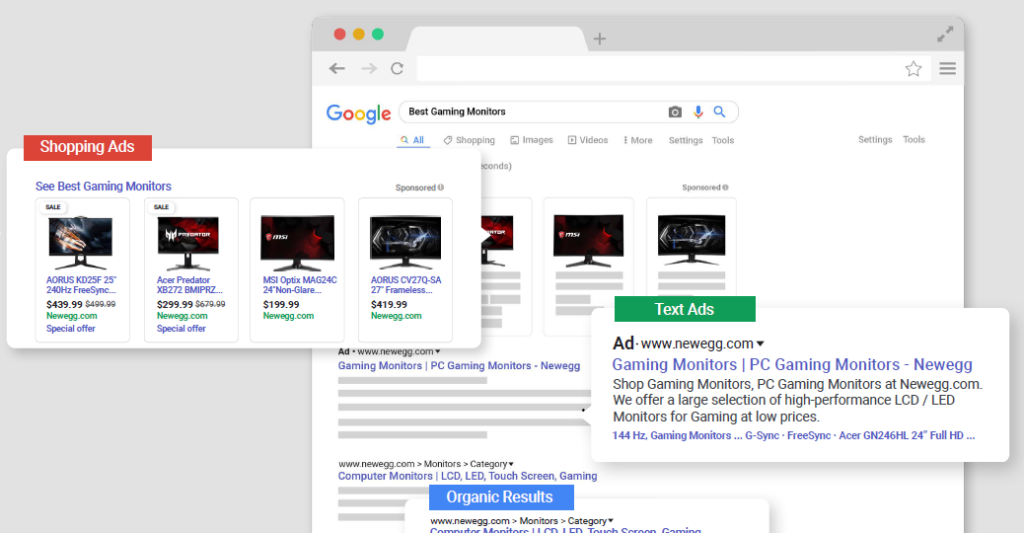More than 70,000 search queries per second occur on Google. With most searchers performing up to 4 searches a day. As the largest search network in the world, it’s a no brainer that online retailers should be advertising on Google. Maximizing their visibility using Google’s advertising capabilities is one of the most effective ways to get their products in front of the right customers at the right time. The two most effective ways of advertising on Google utilizes Google Shopping Ads and Google Text Ads. This article highlights optimization tactic that can be quickly implemented in an effort to help you get the most bang for your buck as you advertise on Google.
Before we get started, here’s a quick recap of both advertising models.
What are Google Shopping Ads?
Google Shopping Ads is the most popular method for advertising on Google. This approach of marketing is geared towards product-based advertisers. When a customer searches for a product, you’ll notice product listings appear at the top of the search. Typically listings will feature an image, product description, price, ratings, shipping information, and the name of the retailer.
What are Google Text Ads?
Google Text Ads function similarly, they appear at the top of search engine result pages (SERPs), but are presented as text instead of images. The notable difference is that you’ll have ample amount of ad copy space where you can go beyond listing the product title and features. Online retailers tend to include special promotional offers to entice customers to buy.

What are the major differences?
Google Shopping Ads typically target customers with high intent to purchase. For example, a customer searching computer monitors from a specific manufacturer is demonstrating a higher intent to purchase from them compared to customer who is just searching “computer monitors.” Whereas Google Text Ads are perfect for advertisers marketing broader segments or groups of products or services. Text Ads better serve customers who are in the research phase of their shopping journey. Their intent isn’t to purchase a specific product or vendor yet, but to look at an assortment.
When advertising on Google, it is critical that marketers have a grasp on purchasing intent so they can formulate an appropriate marketing strategy leveraging the right tools.
Optimizing Google Shopping Ads
Google Shopping Ads rely heavily on the strength of your product feeds. Needless to say, merchants need to make sure their feeds are accurate, displaying the correct information both on Google and their website.
Pro Tip #1: Simplicity over complexity when it comes to your product images. The product image can make or break your ad. Make sure you abide by the terms and conditions Google outlined. Otherwise, your product feed may be suspended. Avoid utilizing watermarked or edited images. A simple product image on a white background is best. Avoid featuring explicit content as well.
Pro Tip #2: Feature accurate pricing and product descriptions. This is straightforward. The pricing on your Google Shopping ad should be mirrored by your website. You’re not bidding on keywords, but your product descriptions are what customers search for. An effective description should include brand name, model, and succinctly highlight one to two features.
Pro Tip #3: Organize your Product Ad Groups. This is contingent on your assortment. If you have a wide assortment, you may want to consider breaking them down into smaller groups with commonalities. If you have multiple brands you might segment it by brands and then under brands further break it down by the main categories. You can further break the main categories into sub-groups. The takeaway is this focuses your bidding and improves your return on ad spend (ROAS) since you will most likely set your bids at the product level where product may share the same features.
Pro Tip #4: Start small. Select a few categories, assess its performance over a set period of time. This will give you a baseline. You then can begin making micro-adjustments, assessing their impact until you’re achieving the results you want.
Optimizing your Google Text Ads
Where Google Shopping Ads rely heavily on your product feeds, optimizing your Google Text ads relies on several factors—keywords, offer, location, and ad copy. These are the areas you’ll want to focus on.
Pro-Tip #1: Know which keywords to bid on. As straight-forward as it sounds, there are nuances that can impact your ROAS. Once you’ve determined which keywords to bid on, assuming you’re not bidding on high volume terms, you need to start leveraging negative keywords. Negative keywords are search queries where you don’t want your ads to surface for. If you’re selling computer monitors you don’t want to appear for search queries such as baby monitors. In this example, baby monitors would be a negative keyword. Having negative keywords ensures your ad does not surface for irrelevant queries where accidental clicks would drive up costs-per-click without any return.
Pro Tip #2: Adjust your feed based on days and times of the week. The idea is you want your ads to surface on times where customer activity is at its highest in terms of impressions, clicks, and click-through rate. Another lever to adjust is the geo-location where ads can be served to specific locations. This is only applicable if online merchants have physical locations for product pickups. Utilizing both these levers, advertisers can target the right customers at the right time.
Pro Tip #3: Optimize your ad copy and landing pages. Your ad copy should be clear utilizing the right keywords, communicating the offer and benefits, and providing a compelling call-to-action. If a customer lands on your landing page their intent to purchase is much higher. Ensure your landing pages are delivering exactly what the ad copy is advertising for. Landing pages should also expand on the offer details, offering greater detail so consumers have all the relevant information to make a purchase.
What happens next?
Many online sellers utilizing Google Shopping Ads and Text Ads are finding that managing feeds and ad copy can be a tedious task, especially if they’re using both. Brands and resellers may find it challenging to compete against organizations whose marketing budget dwarfs theirs.
Mitigating these challenges is what Search Engine Marketing teams at Newegg can do for you. Take advantage of Newegg’s domain authority. Leveraging domain authority means less dollars spent getting your products and offers in front of the right customers at the right time. Let Newegg’s team of SEM experts assess your analytics, making the necessary adjustments so you’re achieving your ROAS goals.
With the Holiday season quickly approaching this is an opportunity you don’t want to miss out on.
Looking to jump start your Holiday planning? Get started by visiting https://www.newegg.com/sellers/index.php/marketing-search-engine-marketing/ or contact us at marketplacemarketing@newegg.com

Author Bio:
Mark Barlis, Content Marketing Manager | Newegg.com/sellers
Mark has been working in the e-commerce sector for more than a decade where he’s developed go-to-market content strategies for brands. At Newegg, he is part of the Seller Marketing team where he focuses on crafting strategies and content designed to educate sellers on best practices when selling online.
LinkedIn: https://www.linkedin.com/in/markhbarlis/